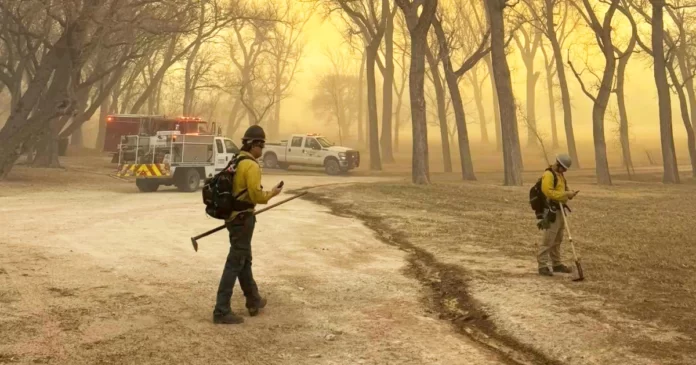The Texas Panhandle continues to face the devastating impact of wildfires, with over 1.2 million acres of land scorched by the relentless blaze. The wildfires, fueled by dry conditions and strong winds, have ravaged vast swathes of land, posing a significant threat to communities and wildlife in the region.
Firefighters and emergency responders have been working tirelessly to contain the flames and protect lives and property. Despite their efforts, the wildfires continue to spread rapidly, engulfing everything in their path and leaving behind a trail of destruction.
The scale of the wildfires in the Texas Panhandle is unprecedented, with authorities describing the situation as dire. The flames have consumed homes, businesses, and agricultural land, causing extensive damage and displacing countless individuals and families.
In addition to the immediate impact on property and infrastructure, the wildfires have also taken a toll on the environment and wildlife. Ecosystems are being destroyed, and habitats for various species are disappearing at an alarming rate. The long-term effects of the wildfires on biodiversity and ecological balance are yet to be fully realized.
The ongoing wildfires have also prompted widespread concern about air quality and public health. Smoke and ash from the fires have blanketed the region, creating hazardous conditions for residents and exacerbating respiratory issues. Vulnerable populations, including the elderly and those with pre-existing health conditions, are particularly at risk.
As the wildfires continue to rage on, communities across the Texas Panhandle are coming together to support one another in this time of crisis. Local organizations, volunteers, and government agencies are providing assistance to those affected by the wildfires, offering shelter, supplies, and other forms of support.
The response to the wildfires highlights the resilience and solidarity of the people of the Texas Panhandle in the face of adversity. Despite the challenges posed by the ongoing crisis, communities are rallying together to provide aid and comfort to those in need, demonstrating the strength of the human spirit in times of hardship.
Efforts to combat the wildfires are ongoing, with firefighters and emergency personnel working around the clock to contain the blaze. However, the unpredictable nature of the fires and the challenging terrain make their task incredibly difficult.
In the midst of the devastation, there is hope for recovery and renewal. Communities are already beginning the process of rebuilding and restoring what has been lost. With the support of local, state, and federal resources, the Texas Panhandle will eventually overcome this crisis and emerge stronger than ever before.
The wildfires in the Texas Panhandle have garnered national attention due to their unprecedented scale and intensity. The sheer size of the affected area, spanning over 1.2 million acres, has made it one of the largest wildfire incidents in the state’s history. Firefighters from across Texas and neighboring states have been deployed to assist in containment efforts, but the sheer magnitude of the fires has presented significant challenges.
One of the factors contributing to the rapid spread of the wildfires is the region’s arid climate and gusty winds, which create ideal conditions for the ignition and propagation of fires. Additionally, the Texas Panhandle has experienced below-average precipitation levels in recent months, exacerbating drought conditions and further fueling the flames.
The impact of the wildfires extends beyond the immediate destruction of property and natural resources. The economic toll on local communities, including agricultural losses and damage to infrastructure, is expected to be substantial. Farmers and ranchers have reported significant damage to crops, livestock, and equipment, jeopardizing their livelihoods and the region’s agricultural economy.
Furthermore, the wildfires have raised concerns about long-term environmental damage and ecological disruption. The loss of vegetation and destruction of wildlife habitats could have far-reaching consequences for biodiversity and ecosystem health in the Texas Panhandle. Efforts to restore and rehabilitate affected areas will be essential in mitigating these impacts and promoting ecological resilience.
The human cost of the wildfires is also profound, with many residents forced to evacuate their homes and seek shelter elsewhere. The displacement and disruption caused by the fires have taken a toll on the mental and emotional well-being of affected individuals and families. In addition to immediate relief efforts, there is a growing need for long-term support and assistance for those impacted by the wildfires.
Despite the challenges posed by the wildfires, there are signs of hope and resilience among communities in the Texas Panhandle. Volunteers, first responders, and aid organizations have mobilized to provide assistance and support to those in need. The outpouring of generosity and solidarity demonstrates the strength and resilience of the human spirit in times of crisis.
As the wildfires continue to burn, authorities are urging residents to remain vigilant and heed evacuation orders and safety precautions. With continued coordination and cooperation among all stakeholders, there is confidence that the Texas Panhandle will overcome this crisis and emerge stronger than ever before.
The wildfires in the Texas Panhandle represent a significant and ongoing threat to communities, ecosystems, and livelihoods. The widespread devastation and far-reaching impacts underscore the urgent need for coordinated action and support. As recovery efforts continue, the resilience and determination of the people of the Texas Panhandle will be crucial in rebuilding and restoring the region’s vibrant communities and natural landscapes.

